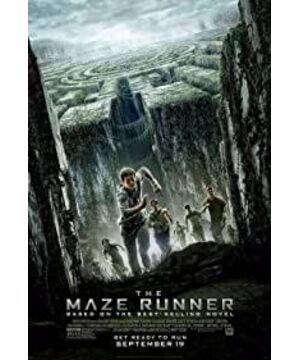The maze walker, the focus is on the "walker". From the movies, they are carefully chosen experimental subjects, like the most gifted and intellectual children on earth in Ender's Game. All the protagonists are the hope for the future. They must be selected and cultivated layer by layer, and finally a few people who can but hold important responsibilities will stand out. The labyrinth is the experimental site for this group of walkers to select projects. It is undeniable that the maze does exist. These protagonists do live in the center of a maze, and they must try their best to escape from the maze. But appearances are not enough. The word labyrinth has something deeper: it represents a kind of adversity, a predicament—not just the actual surrounding environment, but also one’s psychological environment.
Let's review the rules of the game in Experimental Field A: every month, one person will be sent into the field with some basic supplies, and their ultimate goal is to escape this maze. Then, from the first person who is lonely and fearful but actively surviving, to more and more people entering the central venue, a micro-society will be formed. With it comes the rules that bind the society. However, we can see that due to the differences between individuals, this group of people has gradually formed two groups: the walkers and the non-walkers - which represent people who want to escape and settle for the status quo. Two men with no clear political affiliation became chiefs, and the mass assembly was exercising power.
When you think about it, it is understandable that more and more people are content with the status quo, and the emergence of the rightists—they are too conservative, afraid of change, and ultimately prevent change—is even more logical. After all, after three years of exploration, they have not found any way out. , which is undoubtedly a huge blow. Even if the leader did not announce to the masses that they had figured out the overall structure of the labyrinth, in order to keep everyone's hope of escape, the invisible hope is always vulnerable to incendiary words, isn't it?
Therefore, in order to break the stalemate between the left and the right, the entry of a restless, curious and unstable protagonist is undoubtedly the best opportunity to bring about change. However, in addition to artificially leading the change, it is also a historical norm to change in the opposite direction under the influence of external forces. This is the entry of the heroine as the last person to enter the labyrinth: she said the hero's name as soon as she came, and brought two medicines that can relieve the virus and restore memory - forgot to mention , every entrant has their memory erased, they will only remember their name a few days after entering, and know nothing else. The various events after the hero's entry and the memory fragments of those who have used the medicine have made many people suspicious of the hero, and also intensified the right-wing work to seize power. At this point, a revolution is about to be born, either to the left or to the right.
The ending is so predictable that I don't need to say more.
It can be seen that "Maze Runner" and "The Hunger Games", like "Divergent", are both dystopian teenage best-selling sci-fi adaptations. However, although these works have a dystopian world setting, they have not discussed and described too much in this regard. After all, they are not serious subjects, nor are they core readings. But all three share the same pattern: ostensibly stable societies, rebellious protagonists, revolutions, especially Maze Runner and The Hunger Games—both of which are a game-like ordeal of survival.
Although it is not as profound as "The Hunger Games" in terms of content, there are still many bright spots in this film: such as the rhythm, compared to the large foreshadowing of The Hunger Games, this film can be described as straight to the point. Without too much nonsense, I briefly introduce the characters, explain the situation of the protagonist, and introduce conflicts between the characters, and then enter the content that the audience who walks the maze most want to see. In the process, the film keeps throwing out clues to deepen everyone's guesses and thinking, which helps the audience watch the film patiently. It was not until the end, when the protagonists walked out of the labyrinth, that the film revealed the truth to the public, and the audience either "turned out to be like this" or "guessed it would be like this". Anyhow, it's probably better to be straight to the point than the potentially drowsy foreshadowing.
When it comes to juvenile works, the first thing that comes to my mind is Japanese manga. To a large extent, the protagonists are teenagers. Why do people like to tell stories with young people as the protagonists? I think it is probably because young people are full of enthusiasm and vigor, they represent a potential, and they can grow better. More importantly, most young people are active in thinking and do not follow the rules. Moreover, these books are also in line with the North American youth political culture, expressing the young people's concern for politics and their needs for social status. It can be foreseen that in the next few years, these little fresh meats will definitely capture the world's big screen in an all-round way.
In fact, the author wants to spit out the idea of the maze in the movie. I thought it would be a completely random maze, because complete randomness or near randomness would make every change in the maze unfounded, and the passers-by must make decisions on the spot, so that such a maze escape would be very exciting. Unexpectedly, there is a pattern to follow, which is probably to provide clues for the final decryption. However, from the perspective of the characters in the film, this mode is fixed in a maze that only takes time to find out, but after three years there is still no one to clear the level, the blow to hope and the destruction of the spirit are far earlier than a completely random I know that the maze that cannot be broken is huge. In particular, there is still the obstruction of the rightists who are content with the status quo and are afraid of change, so that the seemingly stable society does not really produce revolution until the protagonist enters, and it is not until three years later that people really want to escape and ascend to heaven.
Of course, this maze escape is only part of the experiment, and there will be more and more ruthless mazes waiting for the protagonists. The author can even say that as long as the creativity is enough, as many mazes as can be designed, this movie can be made as many more.
View more about The Maze Runner reviews











